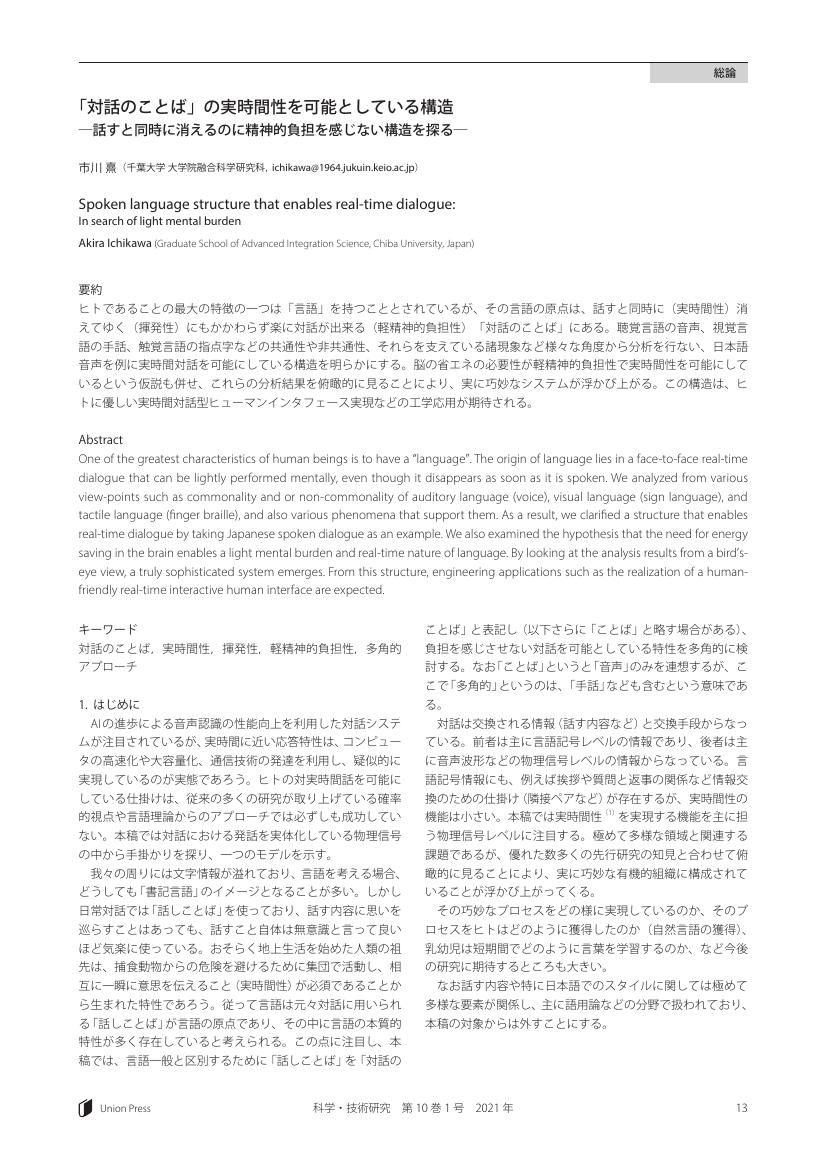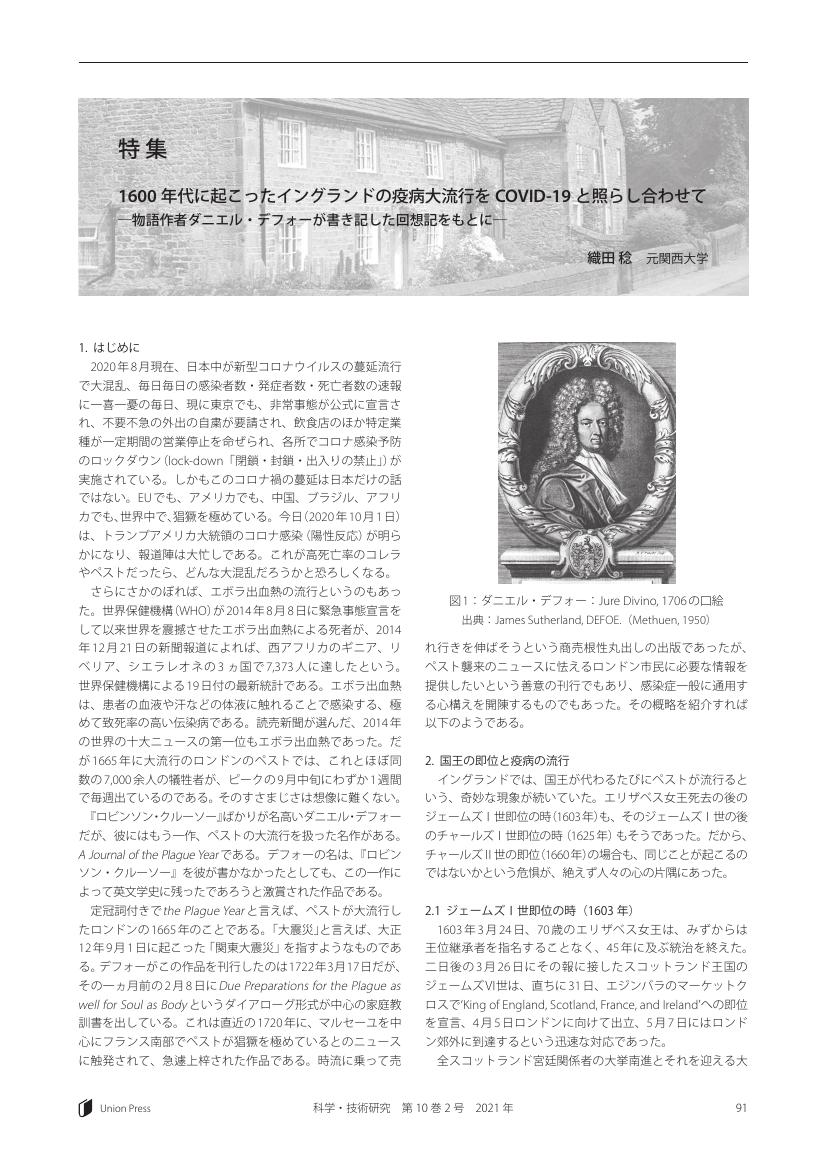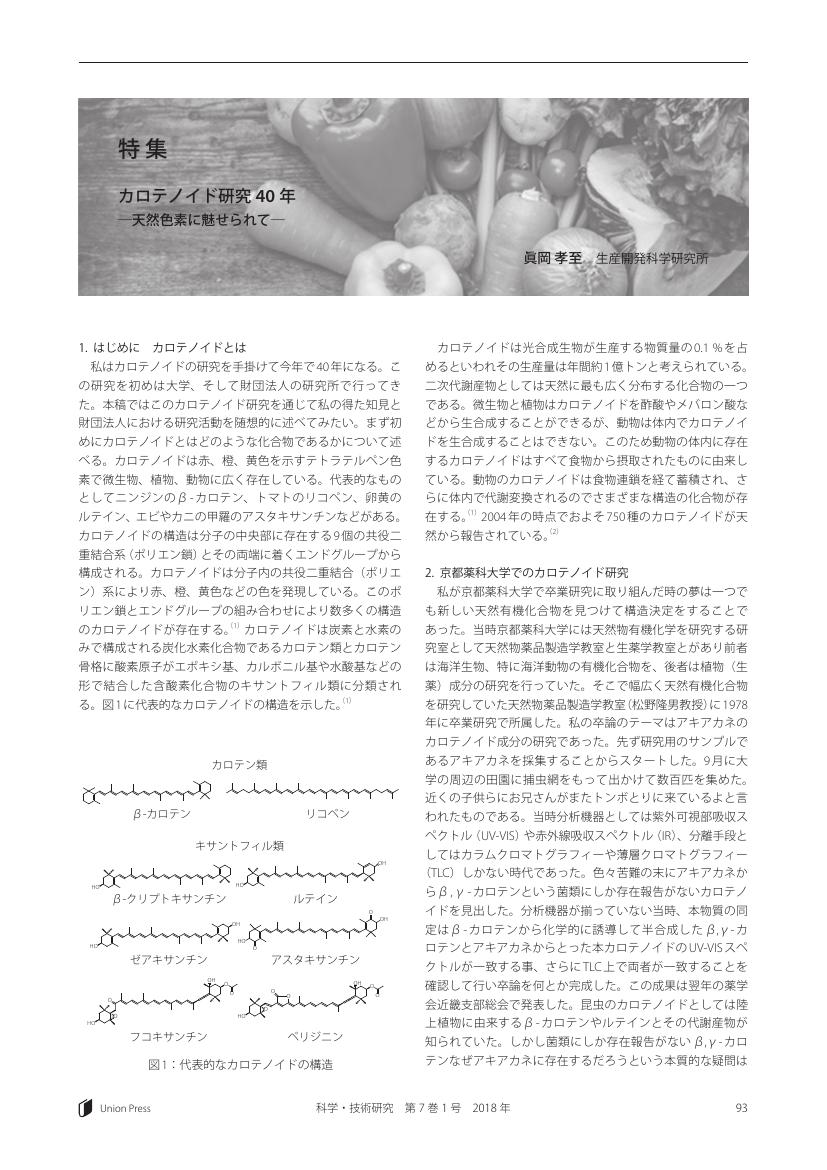2 0 0 0 OA 視覚と聴覚のバイオフィードバックにおける集中力向上効果の比較検討
- 著者
- 渡部 真 宍戸 道明
- 出版者
- 科学・技術研究会
- 雑誌
- 科学・技術研究 (ISSN:21864942)
- 巻号頁・発行日
- vol.5, no.1, pp.41-46, 2016 (Released:2016-07-07)
- 被引用文献数
- 1
人間の精神状態はスポーツや知的作業の結果に影響を与え、とくに高い集中状態のとき良好な結果を得ることができる。この集中力向上のアプローチのひとつにバイオフィードバック (Biofeedback: BF) が挙げられる。BFは、工学的な手法を用いて生体情報を利用者の視覚あるいは聴覚へとフィードバックし、心身の随意的制御を可能とする技法である。このとき、生体情報の呈示手法の違いにより集中力向上効果には差異が生じると考えられる。そこで本研究では、集中力向上を目的としたBFの装置の開発設計を行い、視覚と聴覚のBFにおける集中力の向上効果を比較した。とくに(1)BF前後における集中力の向上度、(2)継続的なBFによる平均集中力の推移について評価した。実験(1)では、被験者は12名とし呈示手法により6名ずつに分け、各被験者の安静時とBF時の平均集中力を比較した。その結果、視覚呈示法は6名中5名、聴覚呈示法は6名全員の集中力が向上した。一方、実験(2)では被験者3名とし、実験(1)と同様の実験を10日間継続して行った。その結果、両呈示手法にて集中力の向上が確認された。しかし、関心意欲の低下や、聴覚呈示法が困難であるために向上効果にばらつきが生じるなどの問題点が明らかとなった。以上の結果より、BFの効果は感覚器官の特性に依存しないことが明らかとなった。そのため、BFの装置の設計では呈示手法のデザインが重要であるといえる。
- 著者
- Yu Saito Yuto Koseki Bunpei Hatano Kazuaki Sato Susumu Okubo Hitoshi Ohta Tateaki Ogata
- 出版者
- 科学・技術研究会
- 雑誌
- 科学・技術研究 (ISSN:21864942)
- 巻号頁・発行日
- vol.7, no.1, pp.61-68, 2018 (Released:2018-07-05)
The spin-trapping ESR (ST-ESR) method, which observes unstable radicals as stable spin adducts using electron spin resonance (ESR), is an effective experimental method for evaluating chemical reactions involving radical reactions. For instance, reactive oxygen species (ROS) such as hydroxyl radicals and so on is trapped well by spin-trapping reagent like as DMPO. In this research, we considered the analytical conditions of generation and detection of singlet oxygen. All conditions were decided based on the viewpoints of high usability for the singlet oxygen scavenging/quenching evaluating method. In addition, all experimental conditions were examined with a solvent-independent measurement method. In this study, a nonaqueous solution is N,N-dimethylformamide (DMF), and an aqueous solution is phosphate buffer solution (PBS, 100 mM pH 7.4). In each solvent CDCl3 or D2O was added at a 10 vol.% ratio respectively. Because heavy solvent was previously reported as an extending lifetime of singlet oxygen. The experimental conditions of singlet oxygen were examined by two different generation/detection methods. Photosensitization method using organic dye and thermal decomposition method by naphthalene derivative endoperoxide were studied as generation method, and 4,4’-bis (1-p-carboxyphenyl-3-methyl-5-hydroxyl) pyrazole (DRD156) and 2,2,5,5-tetramethyl-3-pyrroline-carboxamide (TPC) were studied as detection reagent, respectively. As a result, DRD156 and thermolysis method was good combination for singlet oxygen generation and detection in aqueous solution (around neutral condition) and nonaqueous solution.
2 0 0 0 OA 母語対話の話者交替タイミング
- 著者
- 市川 熹 大橋 浩輝 仲 真紀子 菊池 英明 堀内 靖雄 黒岩 眞吾
- 出版者
- 科学・技術研究会
- 雑誌
- 科学・技術研究 (ISSN:21864942)
- 巻号頁・発行日
- vol.5, no.1, pp.113-122, 2016 (Released:2016-07-07)
母語話者の話者交替時の重複タイミング現象である話者移行適格場(TRP)に注目し、日本語と英語について、それぞれの母語話者とその言語を十分に習得している非母語話者の実時間対話を分析した。両言語ともに、対話者が母語話者の組み合わせ以外ではTRPの制約が成立していなかった。このことは、非母語話者が発信している言語情報は話者交替の予告情報にはならず、言語情報の裏に必然的に存在するプロソディにあることを示唆している。また日本語母語話者の5歳児と6歳児と成人の対話を分析し、さらに先行研究結果を参考にしたところ、日本語母語のTRPの制約は5歳児ころまでに獲得されることが推察された。母語話者の話者交替タイミング制御のモデルを提案した。
1 0 0 0 OA J-POPの想起に関する実験的検討 楽曲の構造に着目して
- 著者
- 小槻 智彩
- 出版者
- 科学・技術研究会
- 雑誌
- 科学・技術研究 (ISSN:21864942)
- 巻号頁・発行日
- vol.7, no.1, pp.55-60, 2018 (Released:2018-07-05)
本研究の目的は我々にとって身近な音楽であるJ-POPがどのように思い出されるのかをその構造的特徴に着目して検討することである。実験1では歌のタイトルを手がかりとした歌唱再生実験を行い、大楽節終わりで生じたエラーについて分析を行った。ある大楽節の再生が終わったあとに、本来続くべき大楽節が再生されずに別の大楽節が誤って続けられるエラーでは、大楽節の冒頭から再生が続けられることが多く、大楽節の途中から再生されることは少なかった。この結果から、J-POPの記憶はAメロやサビといった大楽節の冒頭が再生されやすく、歌の再生におけるアクセスポイントとして機能していることが示唆された。実験2ではこの点の検証を行うために、大楽節の終わりと大楽節の途中のフレーズの終わりのメロディを手がかりとし、その後に続く次の大楽節冒頭またはフレーズ冒頭の歌詞を再生する実験を行った。その結果、大楽節冒頭の歌詞はフレーズ冒頭の歌詞よりも再生されやすく、仮説は支持された。J-POPの記憶にはその構造的特徴が反映され、大楽節の冒頭が再生のアクセスポイントとして機能していると考えられる。
1 0 0 0 OA 人工物とともに暮らす社会
- 著者
- 斉藤 了文
- 出版者
- 科学・技術研究会
- 雑誌
- 科学・技術研究 (ISSN:21864942)
- 巻号頁・発行日
- vol.12, no.1, pp.3-16, 2023 (Released:2023-06-30)
- 著者
- 藤原 厚作 鈴木 俊洋
- 出版者
- 科学・技術研究会
- 雑誌
- 科学・技術研究 (ISSN:21864942)
- 巻号頁・発行日
- vol.12, no.1, pp.39-46, 2023 (Released:2023-06-30)
本稿の目的は、農薬の技術(薬剤と散布方法)の発展が、農薬と農業者との間の関係性にいかなる影響を与えたかについて考察し、現代において農薬について論じるときに何を念頭におくべきかを提示することである。そのために、技術哲学の枠組みを参照しながら、農薬についての倫理の実践がどのようにあるべきかを論じた後、フィールドワークによるインタビュー調査の結果について考察する。まず、考察の枠組みを確認するために、技術哲学で提唱されている「技術に同行する倫理学」という構想を参照して、個々の使用や設計の現場における倫理の実践、いわゆる「ボトムアップ型」の倫理の実践の重要性について論じる。ボトムアップ型の倫理の実践の具体例として、1970年代後半に福岡県で起こった減農薬運動について説明する。つぎに、戦後の日本の水稲作における農薬の技術の変遷について概観し、それが、薬剤の低毒化と散布方法の省力化という二つの方向性において発展してきたことを示す。その後、かつて減農薬運動に参加していた農業者を対象として実施したフィールドワークの調査結果を検討し、農薬技術における発展が、農薬と農業者との間の関係性の希薄化という派生的影響をもたらしたことを示す。最後に、以上の知見に基づいて、現代において、我々が農薬を論じるときに何に気をつけなければならないかを考察する。
1 0 0 0 OA 味関連データを基にした日本酒の味のマッピングと分類化
- 著者
- 野田 博行
- 出版者
- 科学・技術研究会
- 雑誌
- 科学・技術研究 (ISSN:21864942)
- 巻号頁・発行日
- vol.11, no.1, pp.23-28, 2022 (Released:2022-06-28)
日本酒の味を糖度(Brix値)計と酸度計、味覚センサーを用いて調べた。試料として、100点の国産日本酒を用いた。味覚値は味覚センサーを用いて、酸味、塩味、旨味、苦味雑味および渋味刺激の5先味と旨味コク、苦味および渋味の3後味を測定した。それぞれの味データを解析した結果、日本酒の味の指標として、Brix値(甘辛)、酸味値(辛さ)および旨味コク値(旨味)が適していると考えられた。この3つの指標を用いたクラスター分析により8つのクラスターに分類された。8つのクラスターをそれぞれの数値を基に、Brix値による甘辛の定義から、クラスター2と3は甘口、これ以外は辛口と判定した。また、濃淡は、酸味値を+4から–2(酸味が強いとプラス)、旨味コク値を+3から–1(旨味が強いとマイナス)で総合評価した。酸度と日本酒度による味分類を基に、辛口でプラスの場合は淡麗辛口、マイナスの場合は濃淳辛口と分類した。甘口でプラスの場合は濃淳甘口、マイナスの場合は淡麗甘口と分類した。その結果、酸度と日本酒度による分類に比べ、濃淳辛口への極端な集中はみられなかった。以上のことから、味の指標として、Brix値、酸味値および旨味コク値を用いることにより、日本酒の味を概ね4つの味に分類でき、酸度と日本酒度による分類より味の違いを見分けられる可能性が示唆された。
1 0 0 0 OA ヒスタミンの生成と遊離ヒスチジンの変化に対する魚介類の保存温度の影響
- 著者
- 小林 尚 佐藤 孝史 菊川 浩史 小林 政人 金子 聡
- 出版者
- 科学・技術研究会
- 雑誌
- 科学・技術研究 (ISSN:21864942)
- 巻号頁・発行日
- vol.10, no.2, pp.139-146, 2021 (Released:2022-01-14)
- 被引用文献数
- 1
ヒスタミンは、主に赤身魚において、不適切な管理が行われた結果、ヒスタミン生成菌が生成するヒスチジン脱炭酸酵素により、遊離ヒスチジンから生成される食中毒の原因物質である。本研究では、市販の魚介類について、魚介類中のヒスタミンおよび遊離ヒスチジン含量を調べるためのモデル試料を調製し、それぞれ5 ℃、10 ℃または25 ℃の温度で、1日、2日、4日または7日間保存する保存試験を行った後、各モデル試料中のヒスタミン含量と遊離ヒスチジン含量を分析した。その結果から、生成したヒスタミン量と遊離ヒスチジン量の変化について研究を行った。保存試験の結果、赤身魚の他、白身魚やその他魚介類において、ヒスタミンの生成と遊離ヒスチジン量の減少が確認された。また保存後に生成されたヒスタミン量は、遊離ヒスチジン量に近い量であることが確認され、保存試験におけるヒスタミン量と遊離ヒスチジン量の変化に相関性が確認された。このことから、魚介類の遊離ヒスチジン量を調べることで、その魚介類を保存した時に生成されるヒスタミンの最大量を予測することができると考えられた。
1 0 0 0 OA 鉛蓄電池多機能型再生装置
- 著者
- 水本 巌 小熊 博 由井 四海 山本 桂一郎
- 出版者
- 科学・技術研究会
- 雑誌
- 科学・技術研究 (ISSN:21864942)
- 巻号頁・発行日
- vol.6, no.2, pp.121-124, 2017 (Released:2018-01-06)
定電流間断充電と短パルス大放電電流を組み合わせて、多機能型劣化鉛蓄電池回復機を開発した。本機は、劣化鉛蓄電池回復機能、定電流・定電圧充電機能、定電流放電機能を備えた多機能型鉛蓄電池回復機である。本機をシリアルケーブルでパソコンに接続することによりインターネットを介して、電流電圧モニタ、遠隔制御、制御プログラムの変更が可能である。そのため蓄電設備に本機を組み込むと、現地に赴かなくても劣化鉛蓄電池の再生・放電試験が可能である。実際に通勤用軽四自動車で4年間使用したエンジン始動用鉛蓄電池について、CCA値および放電時間を同型の新品電池同様に再生した。再生する電池については、エンジン始動用であれば製造時から5年以内、ディープサイクル型の中古電池であれば8年以内の電池が望ましい。
- 著者
- 市川 熹
- 出版者
- 科学・技術研究会
- 雑誌
- 科学・技術研究 (ISSN:21864942)
- 巻号頁・発行日
- vol.10, no.1, pp.13-24, 2021 (Released:2021-07-01)
- 著者
- 織田 稔
- 出版者
- 科学・技術研究会
- 雑誌
- 科学・技術研究 (ISSN:21864942)
- 巻号頁・発行日
- vol.10, no.2, pp.91-98, 2021 (Released:2022-01-14)
1 0 0 0 OA 毛髪にかかる負担を軽減するための吸引式ヘアドライヤーの開発
- 著者
- 岡本 晃 池田 宏史
- 出版者
- 科学・技術研究会
- 雑誌
- 科学・技術研究 (ISSN:21864942)
- 巻号頁・発行日
- vol.2, no.1, pp.75-78, 2013 (Released:2013-07-04)
- 参考文献数
- 6
毛髪は濡れている時に、毛表皮が開いた状態になるので、ヘアドライヤーをかけすぎると毛髪が損傷しやすい。本研究では、これまでの熱風が吹き出し、髪の毛を乾かすものではなく、吸引して髪を乾かす形式のドライヤーの開発を行った。吸引式ヘアドライヤーは、毛髪を吸い込むことにより乾燥させ、カールまたはストレートに形成させることを目的としている。螺旋状の空間に、濡れた毛髪を熱風と共に吸い込み、毛髪の水素結合をカール状、もしくはストレート状に再結合させる。特徴として、ブラシやコームを使用しないため、毛髪を摩擦抵抗などで傷めない。吸引による風が、コームやブラシの役目を行い、摩擦抵抗なしで毛流を整えることができる。ブラシなどで巻きこめない曲毛や短い毛も、馴染ませることができる。また、片手で頭髪を整えることでき、毛髪が飛散せず熱風が顔や頭皮に晒されることがない特徴がある。
1 0 0 0 OA 境界設定問題はどのように概念化されるべきか
- 著者
- 伊勢田 哲治
- 出版者
- 科学・技術研究会
- 雑誌
- 科学・技術研究 = Studies in Science and Technology (ISSN:21864942)
- 巻号頁・発行日
- vol.8, no.1, pp.5-12, 2019-06
1 0 0 0 IR 境界設定問題はどのように概念化されるべきか
- 著者
- 伊勢田 哲治
- 出版者
- 科学・技術研究会
- 雑誌
- 科学・技術研究 (ISSN:21864942)
- 巻号頁・発行日
- vol.8, no.1, pp.5-12, 2019
1 0 0 0 高校生の友人関係とSNS利用に伴うネガティブ経験
- 著者
- 中山 満子
- 出版者
- 科学・技術研究会
- 雑誌
- 科学・技術研究 (ISSN:21864942)
- 巻号頁・発行日
- vol.7, no.2, pp.127-132, 2018
本研究では、高校生の友人関係とSNS利用に伴うネガティブ経験(以下、SNSネガティブ経験)との関連を検討した。近年の日本の高校生の友人関係にはいくつかの類型があると言われる。本研究では、高校一年生(175名)を対象として質問紙調査を実施し、高校生の友人関係を類型化したうえで、友人関係がSNSネガティブ経験の程度にどのような影響を持つのかを検討した。また、SNSネガティブ経験は利用しているSNSに影響されることも想定されるので、本研究では、LINE、Twitter、Instagramの3種類のSNSに着目して、友人関係の類型とSNS利用パターン及びSNSネガティブ経験との関連について分析した。友人関係の類型としては先行研究と類似の関係回避群、気づかい・群れ群、内面関係群の3群を得た。SNSネガティブ経験のうち閲覧強迫、情報拡散不安、社会的比較は、内面関係群に比べて気づかい・群れ群で多いことが示された。また友人関係類型とSNS利用パターンの分析から、内面関係群では複数のSNSを並行利用する傾向にあり、LINE利用時間は3群中もっとも長いこと、関係回避群は他のSNSを利用せずLINEのみを利用する者が多いことが示された。これらの結果から、SNS利用の多寡それ自体よりも友人関係のあり方がSNSネガティブ経験に影響することが示唆され、先行研究で示されている友人関係類型と心理的適応との議論を踏まえて考察された。
1 0 0 0 OA カロテノイド研究40年 天然色素に魅せられて
- 著者
- 眞岡 孝至
- 出版者
- 科学・技術研究会
- 雑誌
- 科学・技術研究 (ISSN:21864942)
- 巻号頁・発行日
- vol.7, no.2, pp.93-100, 2018 (Released:2018-12-30)
1 0 0 0 OA RGB解析を用いる紙製分析デバイスによる環境水中の銅の定量
- 著者
- 古川 真衣 立石 一希 勝又 英之 山口 翔瑚 金子 聡
- 出版者
- 科学・技術研究会
- 雑誌
- 科学・技術研究 (ISSN:21864942)
- 巻号頁・発行日
- vol.9, no.1, pp.25-29, 2020 (Released:2020-06-30)
本研究では、特別な分析機器を使用せずに銅イオンを測定する目的で、検出領域としてウェル状スポットを有する紙製分析デバイス(PAD)を開発した。PADは、トリクロロシランの化学気相成長(CVD)でクロマトグラフィー紙に疎水性障壁を形成させることで作製した。検出・定量領域には、銅との反応で茶色を呈する錯化剤として、ジエチルジチオカルバミン酸(DDTC)を固定した。水試料中の銅の検出に適用した後、作製したPADは、画像として取り込まれ、RGB値へ変換することで定量に適用された。
本研究では、これまでほとんど研究されて来なかった二次下請け、一次下請けおよびセットメーカーの三者間の産業財マーケティングについて、二次下請け企業が両顧客の購買行動を把握しタイムリーな情報活動を行う手法を、事例研究により検討した。購買行動モデルとして、 Shethモデルを三者間関係に拡張したものとそれと関連する情報活動モデルを提案し、X社の一般照明事業を例に購買行動を分析した。その結果、両顧客での採用に向けて、一次下請けの期待形成フェーズ突破が重要なステップである事が判った。また、一次下請けの電気と光学の両技術知識を持つ担当エンジニアの存在は、一次下請け社内の調整力、セットメーカーとの調整力、の両面で二次下請けに有益である可能性を示唆した。さらに、提案や情報提供によりコンフリクト解消した8案件の存在は、コンフリクト解消フェーズにおける情報活動の重要性を示唆した。
1 0 0 0 OA 海洋生態系における「水銀」および「セレン」に関わった40年間の軌跡
- 著者
- 甲斐 徳久
- 出版者
- 科学・技術研究会
- 雑誌
- 科学・技術研究 (ISSN:21864942)
- 巻号頁・発行日
- vol.8, no.2, pp.95-102, 2019 (Released:2020-01-14)
- 参考文献数
- 72
今日に至るまでの足掛け40年間、一貫して海洋生態系における「水銀」および「セレン」を対象として、環境・生物分析化学的ならびに微量元素栄養学的視点からのプロジェクト研究を行ってきた。当初の研究では、主要海洋生態系の両元素をそれぞれ定量し、それぞれのモル基準で換算したモル比(Se/Hg)が自然蓄積される水銀濃度の増大とともに著しく減少し、ほぼ1に漸近することを認めた。環境分析化学的研究では、海水、懸濁物、沈降粒子および底泥中の「セレン」を状態分析することにより、当該海域における物質の鉛直循環および海洋環境を予察した。生物分析化学・微量元素栄養学的研究では、養殖魚で「水銀」蓄積が抑制されるとともに、「セレン」含有酵母飼料を投与することにより、明瞭な肝機能促進が認められた。加えて、魚類非可食部の「水銀」の安全性とともにセレンの効能を利用した健康食品の開発の基盤が期待された。
1 0 0 0 OA 紅茶の亜臨界水抽出による品質の向上
- 著者
- 横田 正 河合 智也 木戸 康嗣 高橋 しほり 宮下 知也 衛藤 英男
- 出版者
- 科学・技術研究会
- 雑誌
- 科学・技術研究 (ISSN:21864942)
- 巻号頁・発行日
- vol.5, no.2, pp.231-234, 2016 (Released:2017-01-12)
紅茶は世界中で飲料される嗜好飲料の一つである。著者らは、緑茶の亜臨界水抽出物が、高濃度カテキン含有でありながら苦渋味を抑制し飲みやすい飲料となったことや、低品質烏龍茶の亜臨界水抽出物は、香気成分が増加し高品質化に適していることを報告した。そこで、紅茶を亜臨界水抽出することにより、香気成分などをはじめとした多くの成分を抽出することができ、新たな飲料の開発に繋がると考え、紅茶の熱水抽出物と亜臨界水抽出物との官能評価、各成分の比較を行った。官能評価では亜臨界水抽出物のほうが、熱水抽出物よりも優れており、3 MPa、140 ℃での抽出が最も良好であった。凍結乾燥物重量、タンパク質、総アミノ酸、グルコース、ガラクトース、マンノース含有量は熱水抽出物よりも多く、温度上昇とともに抽出量も増大した。また、紅茶に重要な香気成分であるリナロール、ゲラニオール、リナロールオキサイド、サリチル酸メチルの量も、熱水抽出物に比べ増大し、亜臨界水抽出の中では、最も低温である110℃での抽出量が最も多かった。このことは、抽出温度が上昇するにつれて香気成分の抽出量が増大した烏龍茶の亜臨界水抽出と異なる結果となり、発酵程度の違いによるものと考えられた。


